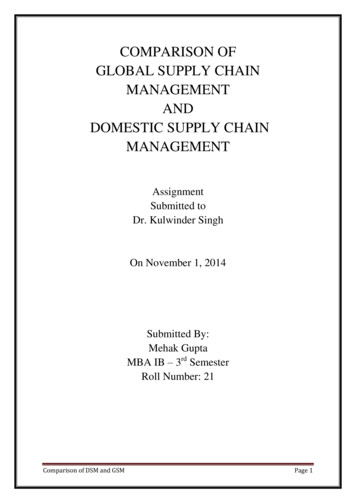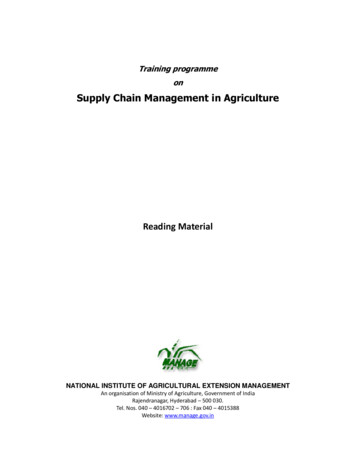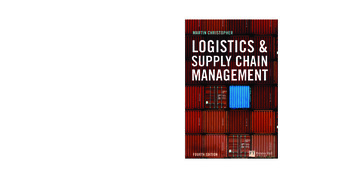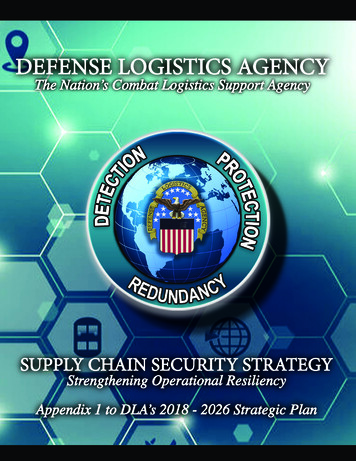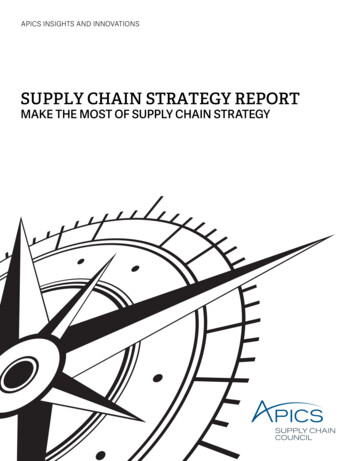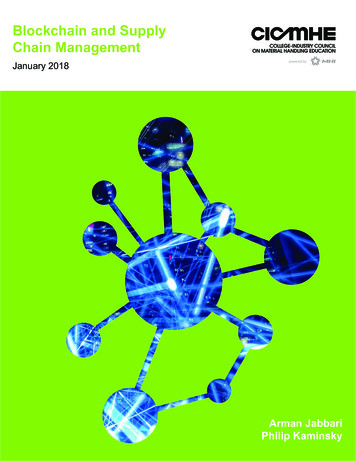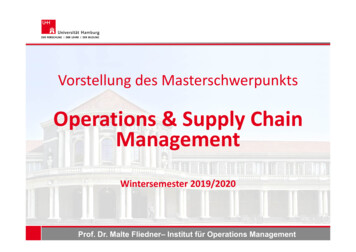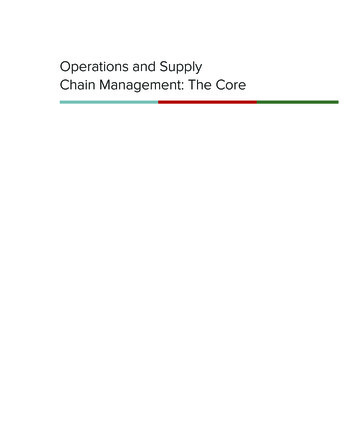
Transcription
Operations and SupplyChain Management: The Corejac49720 fm i-xxiv 1.indd 112/29/15 8:12 PM
The McGraw-Hill Education Series Operations and Decision SciencesOPERATIONS MANAGEMENTBeckman and RosenfieldOperations Strategy: Competing in the21st CenturyFirst EditionBentonPurchasing and Supply Chain ManagementThird EditionBowersox, Closs, and CooperSupply Chain Logistics ManagementFifth EditionBrown and HyerManaging Projects: A Team-BasedApproachSecond EditionBurt, Petcavage, and PinkertonSupply ManagementNinth EditionCachon and TerwieschOperations ManagementFirst EditionCachon and TerwieschMatching Supply with Demand: AnIntroduction to Operations ManagementFourth EditionFinchInteractive Models for Operations andSupply Chain ManagementFirst EditionFitzsimmons and FitzsimmonsService Management: Operations, Strategy,Information TechnologyEighth EditionGehrleinOperations Management CasesFirst EditionHarrison and SamsonTechnology ManagementFirst EditionHayenSAP R/3 Enterprise Software: An IntroductionFirst EditionHillManufacturing Strategy: Text & CasesThird EditionHoppSupply Chain ScienceFirst EditionHopp and SpearmanFactory PhysicsThird EditionJacobs, Berry, Whybark, and VollmannManufacturing Planning & Controlfor Supply Chain ManagementSixth EditionJacobs and ChaseOperations and Supply Chain ManagementFourteenth EditionJacobs and ChaseOperations and Supply Chain Management:The CoreFourth EditionJacobs and WhybarkWhy ERP?First EditionJohnson, Leenders, and FlynnPurchasing and Supply ManagementFifteenth EditionLarson and GrayProject Management: The Managerial ProcessSixth EditionSchroeder, Goldstein, and RungtusanathamOperations Management: ContemporaryConcepts and CasesSixth EditionSimchi-Levi, Kaminsky, andSimchi-LeviDesigning and Managing the Supply Chain:Concepts, Strategies, Case StudiesThird EditionStermanBusiness Dynamics: Systems Thinking andModeling for a Complex WorldFirst EditionStevensonOperations ManagementTwelfth EditionSwink, Melnyk, Cooper, and HartleyManaging Operations Across the Supply ChainThird EditionThomkeManaging Product and ServiceDevelopment: Text and CasesFirst EditionUlrich and EppingerProduct Design and DevelopmentSixth EditionZipkinFoundations of Inventory ManagementFirst EditionQUANTITATIVE METHODS AND MANAGEMENT SCIENCEHillier and HillierIntroduction to Management Science: AModeling and Case Studies Approach withSpreadsheetsFifth Editionjac49720 fm i-xxiv 1.indd 2Stevenson and OzgurIntroduction to Management Science withSpreadsheetsFirst Edition12/29/15 8:12 PM
Operations and SupplyChain Management: The CoreFourth EditionF. Robert JacobsIndiana UniversityRichard B. ChaseUniversity of Southern Californiajac49720 fm i-xxiv 1.indd 312/29/15 8:12 PM
OPERATIONS AND SUPPLY CHAIN MANAGEMENT: THE CORE, FOURTH EDITIONPublished by McGraw-Hill Education, 2 Penn Plaza, New York, NY 10121. Copyright 2017 byMcGraw-Hill Education. All rights reserved. Printed in the United States of America. Previouseditions 2013, 2010, and 2008. No part of this publication may be reproduced or distributed inany form or by any means, or stored in a database or retrieval system, without the prior writtenconsent of McGraw-Hill Education, including, but not limited to, in any network or otherelectronic storage or transmission, or broadcast for distance learning.Some ancillaries, including electronic and print components, may not be available to customersoutside the United States.This book is printed on acid-free paper.1 2 3 4 5 6 7 8 9 0 DOW/DOW 1 0 9 8 7 6ISBN 978-1-259-54972-4MHID 1-259-54972-0Senior Vice President, Products & Markets: Kurt L. StrandVice President, General Manager, Products & Markets: Marty LangeVice President, Content Design & Delivery: Kimberly Meriwether DavidManaging Director: James HeineBrand Manager: Dolly WomackDirector, Product Development: Rose KoosLead Product Developer: Michele JanicekProduct Developer: Camille CorumMarketing Manager: Britney HermsenDirector of Digital Content Development: Douglas RubyDigital Product Analyst: Kevin ShanahanDirector, Content Design & Delivery: Linda AvenariusProgram Manager: Mark ChristiansonContent Project Managers: Kathryn D. Wright, Kristin Bradley, and Karen JozefowiczBuyer: Sandy LudovissyDesign: Debra KubiakContent Licensing Specialists: Beth Thole and Shawntel SchmittCover Image: Earth core structure illustrated with geological layers according to scale—isolatedon black (Texture maps from NASA); Johan Swanepoel/AlamyCompositor: Aptara , Inc.Printer: R. R. DonnelleyAll credits appearing on page or at the end of the book are considered to be an extension of thecopyright page.Library of Congress Cataloging-in-Publication DataNames: Jacobs, F. Robert. Chase, Richard B.Title: Operations and supply chain management. The core / F. Robert JacobsIndiana University, Richard B. Chase, University of Southern California.Other titles: Operations and supply management. The coreDescription: Fourth edition. New York, NY : McGraw-Hill/Irwin, [2016] Originally published as: Operations and supply management. The core. Includes bibliographical references and indexes.Identifiers: LCCN 2015046932 ISBN 9781259549724 (alk. paper) ISBN 1259549720 (alk. paper)Subjects: LCSH: Production management.Classification: LCC TS155 .J273 2016 DDC 658.5—dc23 LC record available athttp://lccn.loc.gov/2015046932The Internet addresses listed in the text were accurate at the time of publication. The inclusion of awebsite does not indicate an endorsement by the authors or McGraw-Hill Education, and McGrawHill Education does not guarantee the accuracy of the information presented at these sites.mheducation.com/higheredjac49720 fm i-xxiv 1.indd 412/29/15 8:12 PM
To Rhonda, Jennifer, Suzy,and Jessica.jac49720 fm i-xxiv 1.indd 512/29/15 8:12 PM
viAbout the AuthorsF. Robert Jacobs is Professor Emeritus of Operations and DecisionTechnologies at Indiana University. He received a B.S. in Industrial Engineering aswell as Computer and Information Science, an MBA, and a Ph.D. in OperationsManagement all from The Ohio State University. He has also taught at theUniversity of Houston and The Ohio State University. He has published 7 booksand over 50 research articles on topics that include enterprise resource planning,inventory control, the design of manufacturing facilities, cellular manufacturing,and the scheduling of manufacturing operations. He is a Fellow of the DecisionSciences Institute and Past President and has received teaching honors such asMBA Teaching Award, Students Award for Teaching Excellence in InternationalBusiness Issues, and Teaching Excellence in Operations Management.Richard B. Chase is Justin B. Dart Professor Emeritus of OperationsManagement at the Marshall School of Business, University of SouthernCalifornia. He received his Ph.D. in Operations Management, as well asan MBA and B.S. from UCLA. He has taught at the Harvard Business School,IMD (Switzerland), and the University of Arizona. His research examines serviceprocess design and service strategy. In 2006 he received a POMS LifetimeAchievement Award for his research in service operations and in 2004 receiveda Scholar of the Year Award by the Academy of Management. In 2009, he washonored in the Production & Operations Management Journal for hiscontributions to Operations Management. He is a Fellow of the Academy ofManagement, Production Operations Management Society, and the DecisionSciences Institute. He was also an Examiner for the Malcolm Baldrige NationalQuality Award. Dr. Chase has lectured/consulted recently on service andexcellence to such organizations as Cisco Systems, Four Seasons Resorts,General Electric, and the Gartner Group.jac49720 fm i-xxiv 1.indd 61/7/16 4:59 PM
viiPrefaceThe goal of this book is to provide you with the essential information that every managerneeds to know about operations and supply chain–related activities in a firm. Thingshave changed dramatically over the last few years. Organization structures are now muchflatter, and rather than being functionally organized, companies often are organized bycustomer and product groups. Today’s manager cannot ignore how the real work of theorganization is done. This book is all about how to get the real work done effectively. Itmakes little difference if you are officially in finance, marketing, accounting, or operations: The value-added work, the process of creating and delivering products, needs tobe completed in a manner that is both high quality and maximally efficient. Many of thethings you do, or will do, in your job are repetitive, even some of the most creative andhigh-profile activities. You should think of this course as preparing you to be your mostproductive and helping you help your organization be its most productive.We can consider the importance of the material in this book on many levels, but let’sfocus on three. First, consider your role as a business unit manager with people workingunder your supervision. Next, in the longer term, you probably have aspirations to becomea senior executive with responsibility for multiple businesses or products. Finally, you maydecide to specialize in operations and supply chain management as a long-term career.In your role as a manager with people working under your supervision, one of yourmajor duties will be to organize the way work is done. There needs to be some structureto the work process, including how information is captured and analyzed, as well as howdecisions and changes and improvements are made. Without a logical or structuredapproach, even a small group may be subject to errors, ineffiencies, and even chaos.Designing efficient process flows is an important element of getting a group to worktogether. If your group is involved in creative activities such as designing cars, buildings,or even stock portfolios, there still needs to be structure to how the work is done, whois responsible for what, and how progress is reported. The concepts of project management, manufacturing and service process design, capacity analysis, and quality in thistext are all directly related to the knowledge you will need to be a great supervisor inyour organization, and getting your group to work productively and efficiently will leadto success and more responsibility for you.Next, think about becoming a senior executive. Making acquisitions, planning mergers, and buying and selling divisions will get your name and picture in business magazines. Deals are easily explained to boards, shareholders, and the media. They arenewsworthy and offer the prospect of nearly immediate gratification, and being a dealmaker is consistent with the image of the modern executive as someone who focuses ongrand strategy and leaves operations details to others. Unfortunately, the majority of dealsare unsuccessful. The critical element of success, even with the grandest deals, can stillbe found most often in the operational details.Real success happens when operational processes can be improved. Productivityimprovements from things such as sharing customer service processes, purchasing systems, distribution and manufacturing systems, and other processes can lead to greatsynergies and success. Operations accounts for 60 to 80 percent of the direct expensesthat limit the profit of most firms. Without these operations synergies, designed andimplemented by executives with a keen understanding of the concepts in this book,companies are often left with expensive debt, disappointed customers and shareholders,and pressure on the bottom line—on earnings.jac49720 fm i-xxiv 1.indd 712/29/15 8:12 PM
viiiPrefaceFinally, you may be interested in a career in operations and supply chain management.Well, you are not alone. Professional organizations such as APICS, the Institute forSupply Management, and the Council of Supply Chain Management Professionals havewell over 200,000 members participating in regular monthly meetings, annual conferences, and certification programs. Entry-level jobs might be as a forecast strategist, project manager, inventory control manager, production supervisor, purchasing manager,logistics manager, or warehouse specialist. In addition, top operations students mayobtain their initial jobs with consulting firms, working as business process analysts andsystem design specialists.We encourage you to talk to your instructor about what you want to get out of thecourse. What are your career aspirations, and how do they relate to the material in thiscourse? Write your instructor a short e-mail describing what you want to do in thefuture—this is invaluable information for tailoring the material in the course to your needs.As you work through the text, share your experiences and insights with the class. Beingan active student is guaranteed to make your experience more valuable and interesting.AcknowledgmentsSpecial thanks to Paul Schikora, Indiana State University, for his insight and work onthe instructor’s material for this edition of the book.Also, special thanks to William Berry, Professor Emeritus, Queens College, for preparing the Test Bank and accuracy checking Connect material; Ronny Richardson, Kennesaw State University, for preparing narrated learning resources; Gregory DeYong,University of Michigan, Flint, for revising the PowerPoint slides and revising Learnsmart;and Larry White, Eastern Illinois University, for accuracy checking Connect material.Thanks to the McGraw-Hill development and production team who made this possible—Camille Corum, Product Developer; Dolly Womack, Executive Brand Manager; KathrynWright, Core Project Manager; Kristin Bradley, Assessment Project Manager; BritneyHermsen, Marketing Manager; and Debra Kubiak, Senior Designer.We appreciate our former executive editor, Dick Hercher. His brilliant guidance andunwavering dedication to working with us on early edition of the book, has been a constant motivator.Last, but certainly not least, we thank our families. We have stolen countless hoursaway for this project; time that would otherwise be spent with them. We sincerely appreciate their support.F. Robert JacobsRichard B. Chasejac49720 fm i-xxiv 1.indd 81/7/16 4:58 PM
ixA Note to InstructorsOperations and Supply Chain Management: The Core derives its title from a combinationof ideas and trends. The book is designed to be lean and focused, much in the tradition ofthe concepts taught in the book. The topics selected are the result of the study of the syllabiof dozens of representative U.S. universities. There are a wide variety of topics covered, manymore than could be covered in a single course. Our “big book,” Operations and Supply ChainManagement, is comprehensive and is intended for those who want to pick and choose topics that best fit the objectives of their course. The “Core” book covers the topics most commonly included in these courses and has material sufficient for a 12- to 15-week course.As is well known in the field, success for companies today requires successfullymanaging the entire supply flow, from the sources of the firm, through the value-addedprocesses of the firm, and on to the customers of the firm.In Operations and Supply Chain Management: The Core 4e, we take students to thecenter of the business and focus on the core concepts and tools needed to ensure thatthese processes run smoothly.Discussion of Fourth Edition RevisionsMany of the revisions to the fourth edition have been driven by our focus on supplychain analytics. Supply chain analytics involves the analysis of data to better solve business problems. We recognize that this is not really new since data have always been usedto solve business problems. But what is new is the reality that there are a great dealmore data now available for decision making.In the past, most analysis involved the generation of standard and ad hoc reports thatsummarized the current state of the firm. Software allowed query and “drill down”analysis to the level of the individual transaction, useful features for understanding whathappened in the past. Decision making was typically left to the decision maker based onjudgment or simple alerting rules. The new “analytics” movement takes this to a newlevel using statistical analysis, forecasting to extrapolate what to expect in the future, andeven optimization, possibly in real time, to support decisions.In this new edition we have refined the 11 Analytic Exercises that have proven to beso popular in our books. These Analytic Exercises use settings that are modern andfamiliar to students taking the course. They include Starbucks, cellphones, notebookcomputers, Taco Bell Restaurant, Toyota, a retail Website–based company, and industrialproducts that are sourced from China/Taiwan and sold globally.In this book, all the of the chapters have been designed to be independent. We haveput much effort into the organization of the book, but recognize that our organizationmight not align with the way you are using the material in your course. In addition, manyof you may custom publish a version of the book to exactly meet your needs. The chapters have been design to allow this type of customization.The chapters are all now tightly organized by special learning objectives. The learningobjectives for the chapter are defined at the start. Special contiguous sections are designedto cover each objective. The chapter summary, discussion and objective questions arealso organized by learning objective. This new organization allows material to be assignedat the level of learning objective. If the desire might be to skip some advanced techniques,for example, this can be easily done by not assigning the specific learning objective. Thisallows considerable flexibility in how the material is used in a class.The material has also been adapted to work well with electronic media, since this isnow becoming the media of choice at many universities.jac49720 fm i-xxiv 1.indd 912/29/15 8:12 PM
xTechnologyMcGraw-Hill Connect Less Managing. More Teaching. Greater Learning.McGraw-Hill Connect is an online assignment andassessment solution that connects students with thetools and resources they’ll need to achieve success. McGraw-Hill Connect helps preparestudents for their future by enabling faster learning, more efficient studying, and higherretention of knowledge.McGraw-Hill Connect FeaturesConnect offers a number of powerful tools and features to make managing assignmentseasier so faculty can spend more time teaching. With Connect, students can engage withtheir coursework anytime and anywhere making the learning process more accessible andefficient. Connect offers you the features described below.Simple Assignment ManagementWith Connect, creating assignments is easier than ever, so you can spend more timeteaching and less time managing. The assignment management function enablesyou to: Create and deliver assignments easily with selectable end-of-chapter questions andtest bank items. Streamline lesson planning, student progress reporting, and assignment grading tomake classroom management more efficient than ever. Go paperless with the eBook and online submission and grading of student assignments.Smart GradingWhen it comes to studying, time is precious. Connect helps students learn more efficiently by providing feedback and practice material when they need it, where they needit. When it comes to teaching, your time also is precious. The grading function enablesyou to: Have assignments scored automatically, giving students immediate feedback ontheir work and side-by-side comparisons with correct answers. Access and review each response; manually change grades or leave comments forstudents to review. Reinforce classroom concepts with practice tests and instant quizzes.Instructor LibraryThe Connect Instructor Library is your repository for additional resources to improvestudent engagement in and out of class. You can select and use any asset that enhancesyour lecture. The Connect Instructor Library includes: jac49720 fm i-xxiv 1.indd 10PowerPoint SlidesText FiguresInstructor’s Solutions ManualTest BanksExcel Templates12/29/15 8:12 PM
TechnologyxiStudent Study CenterThe Connect Student Study Center is the place for students to access additional resources.The Student Study Center offers students quick access to study and review material.Student Progress TrackingConnect keeps instructors informed about how each student, section, and class is performing, allowing for more productive use of lecture and office hours. The progresstracking function enables you to: View scored work immediately and track individual or group performance withassignment and grade reports. Access an instant view of student or class performance relative to chapter headings.Tegrity Campus: Lectures 24/7Tegrity Campus is a service that makes class time available 24/7by automatically capturing every lecture in a searchable formatfor students to review when they study and complete assignments. With a simple oneclick start-and-stop process, you capture all computer screens and corresponding audio.Students can replay any part of any class with easy-to-use browser-based viewing on aPC or Mac. Educators know that the more students can see, hear, and experience classresources, the better they learn. In fact, studies prove it. With Tegrity Campus, studentsquickly recall key moments by using Tegrity Campus’s unique search feature. This searchhelps students efficiently find what they need, when they need it, across an entire semester of class recordings. Help turn all your students’ study time into learning momentsthat are immediately supported by your lecture. To learn more about Tegrity, watch atwo-minute Flash demo at www.tegrity.com. OPERATIONS MANAGEMENT AND THE AACSBAssurance of Learning ReadyMany educational institutions today are focused on the notion of assuranceof learning, an important element of some accreditation standards. Operations and Supply Chain Management is designed specifically to supportyour assurance of learning initiatives with a simple yet powerful solution.Each test bank question for Operations and Supply Chain Management maps to aspecific chapter learning outcome/objective listed in the text. You can use our test banksoftware, EZ Test and EZ Test Online, or in Connect Operations Management to easilyquery for learning outcomes/objectives that directly relate to the learning objectives foryour course. You can then use the reporting features of EZ Test to aggregate studentresults in similar fashion, making the collection, presentation, and assurance of learningdata simple and easy.AACSB StatementMcGraw-Hill Education is a proud corporate member ofAACSB International. Understanding the importance andvalue of AACSB accreditation, Operations and Supply ChainManagement recognizes the curricula guidelines detailed in the AACSB standards forbusiness accreditation by connecting selected questions in the test bank to the six generalknowledge and skill areas in the AACSB standards Assessment of Learning Standards.jac49720 fm i-xxiv 1.indd 1112/29/15 8:12 PM
xiiTechnologyThe statements contained in Operations and Supply Chain Management are providedonly as a guide for the users of this textbook. The AACSB leaves content coverage andassessment within the purview of individual schools, the mission of the school, and thefaculty. While Operations and Supply Chain Management and the teaching package makeno claim of any specific AACSB qualification or evaluation, we have within the TestBank labeled questions according to the six general knowledge and skill areas.McGraw-Hill Customer Experience Contact InformationAt McGraw-Hill, we understand that getting the most from new technology can be challenging. That’s why our services don’t stop after you purchase our products. You cane-mail our Product Specialists 24 hours a day to get product-training online. Or you cansearch our knowledge bank of Frequently Asked Questions on our support Website. ForCustomer Support, call 800-331-5094 or visit mpss.mhhe.com. One of our TechnicalSupport Analysts will be able to assist you in a timely fashion.jac49720 fm i-xxiv 1.indd 1212/29/15 8:12 PM
WalkthroughMajor Study and Learning FeaturesThe following section highlights the key featuresdeveloped to provide you with the best overall textavailable. We hope these features give you maximumsupport to learn, understand, and apply operationsconcepts.CHAPTER 2Strategy andSustainabilityChapter OpenerLearning ObjLO2–1ectivesKnow what asustainable business strategyand supply chis and how itain managemerelates to operant.LO2–2tionsDefine operations and supplychainstrategy.LO2–3Explain how operations and supply chain strLO2–4ategies are imUnderstand whplemented.y strategies have implicationsLO2–5relative to businEvaluate produess risk.ctivity in operations and supply chain management.MISSION STATEMENTS WITH ASBEYOND MAKPIRATIONSING A PROFITCompanies such as Clif Barand Whole Foments that deods Market hapict a focus thave bold missiot goes well ben stateConsider Clifyond profit anBar’s 5 Aspiratid shareholderons and Wholewealth.dependence,Foods Markecompany mist’sDeclaration of Intsion statemenerts that describeto the environment, the commtheir aspirations relatedunity, their empanies needployees, andoperations anmaking a prod supply chainfit. Comthe firm as astrategies thawhole.t align with thegoals ofjac49720 ch02 024-043.indd 2412/25/15 1:57AMjac49720 fm i-xxiv 1.indd 1312/29/15 8:12 PM
xivWalkthroughOpening VignettesEach chapter opens with a short vignette to set the stage and help piquestudents’ interest in the material about to be studied. A few examplesinclude: Mission Statements with Aspirations Beyond Making a Profit, Chapter 2From Bean to Cup: Starbucks Global Supply Chain Challenge, Chapter 3Inside the iPad, Chapter 9The Factoryless Goods Producers, Chapter 13In the context of major business functions,operations and supply chain managementinvolves specialists in product design, purchasing, manufacturing, service operations,logistics, and distribution. These specialistsways depending on the product or service.For a firm that sells televisions, like Toshiba,these are the functions responsible fordesigning televisions, acquiring materials,coordinating equipment resources to convertmaterial to products, moving the product,and exchanging the final product with the Robyn Beck/AFP/Getty Imagesare mixed and matched in many differentcustomer. Some firms are focused on services, such as a hospital. Here, the contextinvolves managing resources, including the operating rooms, labs, and hospitalbeds used to nurse patients back to health. In this context, acquiring materials,moving patients, and coordinating resource use are keys to success. Other firmsare more specialized, such as Amazon. Here, purchasing, Web site services, logistics,and distribution need to be carefully coordinated for success.In our increasingly interconnected and interdependent global economy, the process of delivering finished goods, services, and supplies from one place to anotheris accomplished by means of mind-boggling technological innovation, clever newapplications of old ideas, seemingly magical mathematics, powerful software, andold-fashioned concrete, steel, and muscle. This book is about doing this at lowcost while meeting the requirements of demanding customers. Success involvesStrategythe clever integration of a great operations-related strategy, processes that candeliver the products and services, and analytics that support the ongoing decisionsProcessesneeded to manage the firm. Our goal in this book is to introduce students to basicoperations and supply chain concepts so they understand how things should bedone and the importance of these functions to the success of the firm.AnalyticsNo matter what your major is in business, understanding operations and supplychain management is critical to your success. If you are interested in the studyof finance, you will find that all of the concepts are directly applicable. Just convertall of those widgets to their value in the currency of your choice and you willjac49720 ch01 002-023.indd 3jac49720 fm i-xxiv 1.indd 1412/25/15 2:11 AM12/29/15 8:12 PM
xvWalkthroughPhotos and ExhibitsPhotos and exhibits in the text enhance the visual appeal and clarifytext discussions. Many of the photos illustrate additional examplesof companies that utilize the operations and supply chain conceptsin their business.Operations and Supply Chain Managementexhibit 1.3The Goods–Services ContinuumPure GoodsFood productsChemicalsMiningCore GoodsAppliancesAutomobilesData storage systemsGoods9chapter 1Core ServicesHotelsAirlinesInternet serviceprovidersPure ServicesUniversityMedicalInvestmentServicesThe Goods–Services ContinuumAlmost any product offeringis a combinationgoodsand services. In Exhibit 1.3, weOperationsand SupplyofChainManagementshow this arrayed along a continuum of “pure goods” to “pure services.” The continuumcaptures the main focus of the business and spans from firms that just produce productsMarshmallow candyto those that only provide services. Pure goods industries have become low-margin comPeeps chicks get amodity businesses, and in order to differentiate, they are often adding some services.quality controlcheck asSomethey moveexamples are providing help with logistical aspects of stocking items, maintainingdown a conveyorextensivebeltinformation databases, and providing consulting advice.inside the Just BornCoregoodsproviders already provide a significant service component as part of theirInc. manufacturingbusinesses.Forexample, automobile manufacturers provide extensive spare parts distrifacility in Bethlehem,Pennsylvania.bution services to support repair centers at dealers. Mike Mergen/Bloomberg/GettyCore service providers must integrate tangible goods. For example, your cable televiImagession company must provide cable hookup and repair services and al
First Edition Benton Purchasing and Supply Chain Management Third Edition Bowersox, Closs, and Cooper Supply Chain Logistics Management Fifth Edition Brown and Hyer Managing Projects: A Team-Based Approach Second Edition Burt, Petcavage, and Pinkerton Supply Management Ninth Edition Cachon and

